Are Dachshunds Good Pets? Absolutely! Dachshunds, also affectionately known as “wiener dogs” or “doxies,” make wonderful companions due to their loyalty, intelligence, and playful nature. At PETS.EDU.VN, we understand the joy and commitment of pet ownership, and we’re here to guide you in understanding why a dachshund might be the perfect addition to your family, offering insights into their care, health, and behavior, ensuring a harmonious life together and providing you with expert advice on dachshund ownership. Discover how these amazing dogs can bring happiness and fun to your life with our comprehensive guide covering everything from dachshund characteristics to training tips and potential health concerns.
1. Understanding the Dachshund Breed
Dachshunds, with their distinctive long bodies and short legs, have a rich history and unique characteristics that make them both charming and challenging pets. Let’s delve into their origins, physical attributes, and temperament to provide a comprehensive understanding of this beloved breed.
1.1. A Brief History
Originally bred in 16th-century Germany, Dachshunds were developed to hunt badgers and other burrowing animals. The name “Dachshund” itself is derived from the German words “dachs” (badger) and “hund” (dog). Their elongated body and short legs allowed them to effectively navigate tunnels, while their courageous nature made them formidable hunters. According to the Dachshund Club of America, their fearless attitude made them suitable for hunting animals much larger than themselves.
1.2. Physical Characteristics
Dachshunds come in two sizes: standard and miniature. Standard Dachshunds typically weigh between 16 and 32 pounds, while miniature Dachshunds weigh under 11 pounds. They also boast three coat varieties: smooth, longhaired, and wirehaired, each requiring different grooming needs. Their color variations are diverse, ranging from solid colors like red and black to patterns like dapple and brindle.
| Feature | Standard Dachshund | Miniature Dachshund |
|---|---|---|
| Weight | 16-32 pounds | Under 11 pounds |
| Height | 8-9 inches | 5-6 inches |
| Common Colors | Red, Black, Dapple | Red, Black, Dapple |
| Coat Varieties | Smooth, Longhaired, Wirehaired | Smooth, Longhaired, Wirehaired |



1.3. Temperament and Personality
Dachshunds are known for their intelligence, courage, and independence. They can be playful and affectionate with their families but may also exhibit stubbornness and a strong prey drive due to their hunting background. As noted by the American Kennel Club, their spirited nature requires consistent training and socialization from a young age.
2. Are Dachshunds Good Pets? Assessing Their Suitability
Deciding whether a dachshund is the right pet for you involves considering various factors. Here’s a breakdown to help you assess if this breed aligns with your lifestyle and expectations.
2.1. Are Dachshunds Good With Families?
Dachshunds can be excellent family pets, particularly for families with older children who understand how to handle them gently. Their playful nature makes them fun companions, but their independent streak means they need consistent training.
2.2. Are Dachshunds Good With Children?
Dachshunds can be good with children if properly socialized and if the children are taught how to handle them respectfully. Dachshunds may not tolerate rough handling, so supervision is essential. Teaching children how to interact gently with dogs is crucial, as highlighted in a guide by the American Society for the Prevention of Cruelty to Animals (ASPCA).
2.3. Are Dachshunds Good With Other Pets?
Dachshunds have a high prey drive, which means they might not be the best fit for homes with small animals like rabbits or hamsters. However, they can coexist peacefully with other dogs and cats if raised together from a young age. Early socialization is key to ensuring they get along well with other pets.
2.4. Activity Level
Dachshunds have a moderate activity level. They need daily walks to stay healthy and prevent weight gain. However, excessive jumping or running can strain their backs, so it’s important to manage their physical activity carefully. Games and puzzle toys can keep them mentally stimulated.
2.5. Living Space
Dachshunds adapt well to apartment living, provided they get enough exercise. Their barking tendency can be a concern, so early training to manage barking is important. A secure yard is ideal, but not essential, as long as they get regular walks.
3. Benefits of Owning a Dachshund
Dachshunds bring numerous joys to their owners. Their unique personalities and endearing traits make them wonderful companions.
3.1. Companionship
Dachshunds are incredibly loyal and affectionate pets. They form strong bonds with their families and enjoy spending time with them, whether it’s cuddling on the couch or going for walks. Their devotion makes them great companions for people of all ages.
3.2. Intelligence
Dachshunds are intelligent dogs, which makes them trainable, albeit sometimes stubborn. They excel in activities that challenge their minds, such as puzzle toys and scent work. Consistent training can help them learn commands and develop good behavior.
3.3. Watchdog Ability
Dachshunds are naturally alert and have a tendency to bark, making them good watchdogs. They will alert you to any unusual activity around your home, providing a sense of security. However, it’s important to train them to not bark excessively.
3.4. Adaptability
Dachshunds are adaptable and can thrive in various living situations, from apartments to houses with yards. They are relatively small and don’t require a lot of space, making them suitable for urban environments.
3.5. Playfulness
Dachshunds are playful and enjoy interactive games. They love toys and are always up for a game of fetch or tug-of-war. Their playful nature can bring a lot of joy and laughter to your home.
4. Potential Challenges of Owning a Dachshund
While dachshunds have many positive attributes, potential owners should be aware of the challenges associated with the breed.
4.1. Back Problems
Dachshunds are prone to intervertebral disc disease (IVDD) due to their long backs and short legs. This condition can cause pain, mobility issues, and even paralysis. Preventive measures include maintaining a healthy weight, avoiding jumping, and using ramps or stairs to help them get on and off furniture. According to the American Animal Hospital Association (AAHA), up to 25% of Dachshunds may develop IVDD in their lifetime.
4.2. Stubbornness
Dachshunds can be stubborn and independent, which can make training challenging. Consistency, patience, and positive reinforcement are essential. Enrolling in obedience classes and working with a professional trainer can be beneficial.
4.3. Barking
Dachshunds are known for their barking, which can be problematic, especially in apartment settings. Training can help manage their barking habits, but it requires persistence and consistency. Understanding the reasons behind their barking, such as boredom or territoriality, can help you address the issue more effectively.
4.4. High Prey Drive
Dachshunds have a strong prey drive, which means they may chase small animals. This can be a concern if you have other pets, especially small ones. Keeping them on a leash during walks and providing alternative outlets for their prey drive, such as toys and games, can help manage this behavior.
4.5. Health Issues
Besides IVDD, dachshunds are prone to other health issues, such as obesity, luxating patella, and dental problems. Regular veterinary check-ups, a healthy diet, and proper dental care are essential for maintaining their health and well-being.
5. Essential Care Tips for Dachshunds
Providing proper care is crucial for ensuring a happy and healthy life for your dachshund.
5.1. Nutrition
Dachshunds need a balanced diet to maintain a healthy weight and prevent obesity, which can exacerbate back problems. Choose a high-quality dog food formulated for small breeds and follow the feeding guidelines provided by your veterinarian. Avoid overfeeding and limit treats.
5.2. Exercise
Regular exercise is important for dachshunds, but it should be managed carefully to protect their backs. Daily walks are ideal, but avoid activities that involve jumping or running. Puzzle toys and interactive games can provide mental stimulation without putting excessive strain on their bodies.
5.3. Grooming
Grooming needs vary depending on the coat type. Smooth-coated dachshunds require minimal grooming, while longhaired dachshunds need regular brushing to prevent mats and tangles. Wirehaired dachshunds need occasional hand-stripping to maintain their coat’s texture. Regular nail trimming and ear cleaning are also important.
5.4. Training
Early socialization and consistent training are crucial for dachshunds. Start training as early as possible and use positive reinforcement techniques. Obedience classes and puzzle toys can help keep them mentally stimulated and prevent behavioral issues.
5.5. Health Care
Regular veterinary check-ups are essential for detecting and preventing health problems. Vaccinations, parasite control, and dental care are also important. Be aware of the signs of IVDD and seek veterinary care immediately if you notice any symptoms.
6. Health Concerns Specific to Dachshunds
Dachshunds are prone to certain health issues that owners should be aware of.
6.1. Intervertebral Disc Disease (IVDD)
IVDD is the most common health problem in dachshunds. It occurs when the discs between the vertebrae in the spine bulge or rupture, causing pain, nerve damage, and paralysis. Prevention involves maintaining a healthy weight, avoiding jumping, and using ramps or stairs. Treatment can range from medication and rest to surgery.
6.2. Obesity
Dachshunds are prone to obesity due to their small size and tendency to overeat. Obesity can worsen back problems and lead to other health issues. A balanced diet and regular exercise are essential for maintaining a healthy weight.
6.3. Luxating Patella
Luxating patella is a condition in which the kneecap slips out of place. It’s common in small breeds like dachshunds. Symptoms include limping or skipping. Treatment can range from pain medication to surgery.
6.4. Dental Problems
Dachshunds are prone to dental problems such as periodontal disease. Regular dental care, including brushing their teeth and professional cleanings, is essential for preventing dental issues.
6.5. Progressive Retinal Atrophy (PRA)
PRA is a degenerative eye disease that can lead to blindness. There is no cure, but early detection and management can help slow the progression. Regular eye exams are important.
7. Training Your Dachshund: Tips and Techniques
Training a dachshund requires patience, consistency, and a positive approach.
7.1. Early Socialization
Expose your dachshund puppy to a variety of people, places, and situations to help them develop into a well-adjusted adult dog. Socialization classes are a great way to help them learn how to interact with other dogs and people.
7.2. Positive Reinforcement
Use positive reinforcement techniques such as treats, praise, and toys to reward good behavior. Avoid punishment, which can damage your relationship with your dog and lead to behavioral problems.
7.3. Consistency
Be consistent with your commands and rules. Everyone in the family should use the same commands and enforce the same rules to avoid confusing your dachshund.
7.4. Short Training Sessions
Dachshunds have short attention spans, so keep training sessions short and engaging. A few minutes of training several times a day is more effective than long, infrequent sessions.
7.5. Addressing Stubbornness
Dachshunds can be stubborn, so be patient and persistent. If your dachshund is being stubborn, try breaking the task down into smaller steps and rewarding them for each step.
8. Dachshund Grooming: Keeping Your Doxie Looking Great
Proper grooming is essential for maintaining the health and appearance of your dachshund.
8.1. Coat Care
The type of coat care your dachshund needs depends on their coat type. Smooth-coated dachshunds require minimal grooming, while longhaired dachshunds need regular brushing to prevent mats and tangles. Wirehaired dachshunds need occasional hand-stripping to maintain their coat’s texture.
8.2. Bathing
Dachshunds don’t need to be bathed frequently. Bathing them too often can strip their coat of natural oils and cause skin problems. Bathe them only when necessary, using a mild dog shampoo.
8.3. Nail Trimming
Regular nail trimming is important for preventing overgrown nails, which can be painful and lead to foot problems. Trim their nails every few weeks, or as needed.
8.4. Ear Cleaning
Check your dachshund’s ears regularly for signs of infection, such as redness, discharge, or odor. Clean their ears as needed, using a veterinarian-approved ear cleaner.
8.5. Dental Care
Regular dental care is essential for preventing dental problems. Brush their teeth daily and provide them with dental chews to help remove plaque and tartar. Schedule professional dental cleanings as recommended by your veterinarian.
9. Finding a Dachshund: Breeders vs. Rescues
When looking for a dachshund, you have the option of buying from a breeder or adopting from a rescue organization.
9.1. Reputable Breeders
If you choose to buy from a breeder, look for a reputable breeder who health tests their dogs and provides a healthy environment. A good breeder will be knowledgeable about the breed and willing to answer your questions. They should also allow you to visit their facility and meet the parent dogs.
9.2. Rescue Organizations
Adopting a dachshund from a rescue organization is a great way to give a deserving dog a loving home. Rescue organizations often have dachshunds of all ages and temperaments available for adoption. They will typically screen potential adopters to ensure they are a good fit for the dog.
9.3. Questions to Ask Breeders and Rescues
Whether you’re buying from a breeder or adopting from a rescue, ask questions about the dog’s health history, temperament, and care requirements. This will help you make an informed decision and ensure you’re prepared to provide the best possible care for your new dachshund.
10. Dachshund FAQs: Addressing Common Concerns
Here are some frequently asked questions about dachshunds.
10.1. Are Dachshunds Easy to Train?
Dachshunds can be challenging to train due to their independent nature, but with patience and consistency, they can learn commands and develop good behavior.
10.2. Do Dachshunds Shed a Lot?
Dachshunds shed moderately year-round. Regular grooming can help reduce the amount of fur that ends up in your home.
10.3. How Much Exercise Do Dachshunds Need?
Dachshunds need about 30 minutes of exercise per day. This can include daily walks and playtime.
10.4. Are Dachshunds Hypoallergenic?
No, dachshunds are not hypoallergenic. They shed moderately and produce dander, which can trigger allergies in some people.
10.5. What is the Average Lifespan of a Dachshund?
The average lifespan of a dachshund is 12-16 years.
10.6. Are Dachshunds Good Apartment Dogs?
Yes, dachshunds are good apartment dogs, provided they get enough exercise and training to manage their barking.
10.7. How Much Does a Dachshund Cost?
The cost of a dachshund puppy can range from $500 to $2,000, depending on the breeder, pedigree, and health screenings.
10.8. Are Dachshunds Prone to Any Specific Health Issues?
Yes, dachshunds are prone to intervertebral disc disease (IVDD), obesity, luxating patella, dental problems, and progressive retinal atrophy (PRA).
10.9. What Should I Feed My Dachshund?
Feed your dachshund a high-quality dog food formulated for small breeds. Follow the feeding guidelines provided by your veterinarian and avoid overfeeding.
10.10. How Can I Prevent Back Problems in My Dachshund?
Prevent back problems by maintaining a healthy weight, avoiding jumping, using ramps or stairs, and providing supportive bedding.
Conclusion: Embracing the Dachshund Life
Dachshunds are wonderful pets that bring joy, companionship, and a unique charm to their owners’ lives. While they come with specific challenges, such as potential health issues and a stubborn streak, understanding their needs and providing proper care can lead to a fulfilling relationship. With the right approach to training, nutrition, and health care, a dachshund can be a loving and loyal member of your family for many years. At PETS.EDU.VN, we believe that informed pet ownership leads to happier pets and happier owners.
Ready to learn more and ensure your dachshund lives its best life?
For expert advice on dachshund care, health, and training, visit PETS.EDU.VN today! We are here to support you every step of the way, offering resources, tips, and personalized guidance to help you provide the best possible care for your beloved dachshund. Whether you’re a first-time pet owner or an experienced dog lover, PETS.EDU.VN is your trusted resource for all things dachshund.
Contact us at 789 Paw Lane, Petville, CA 91234, United States. Whatsapp: +1 555-987-6543 or visit our website at pets.edu.vn for more information.